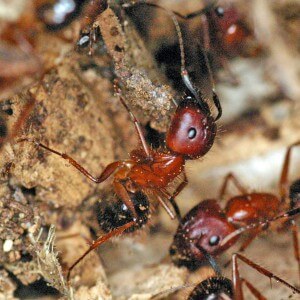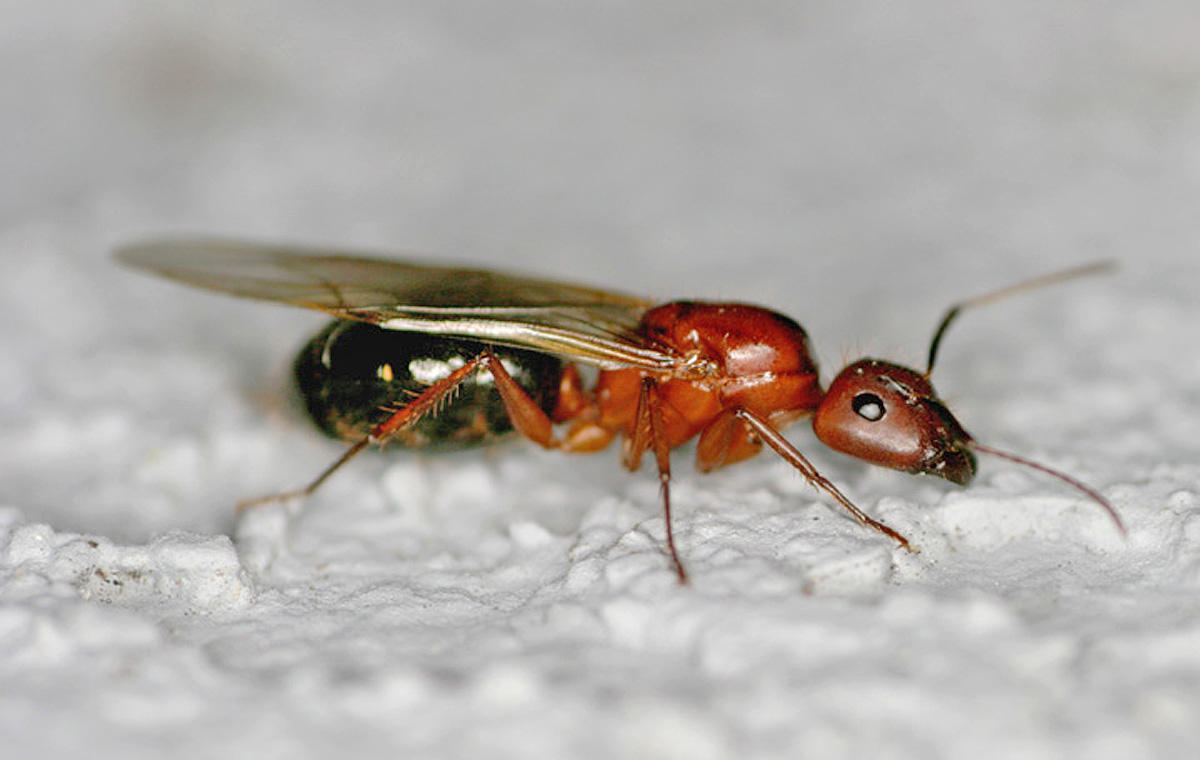 Carpenter ants are a species of ant that can be very detrimental to the structure of your home. Commonly mistaken for termites, carpenter ants burrow into wood the build their nests. However, they do not eat the wood. Carpenter ants remove wood shavings constructing a safe place for their queen and colony. These nests can incredibly weaken wooden structures causing them to collapse. Carpenter ants are quite large for an ant at about 24mm long. They’re difficult to distinguish from regular ants except for a small segment between the thorax and abdomen.
Carpenter ants love moisture.
Damp wood make it easier for carpenter ants to burrow and build their nest. That’s why you may find more ants on decks or other areas where moisture might have soaked into the wood. The ants cut galleries into wood making passages for movement between sections. Around and under windows, roof eaves, decks and porches are the most common places carpenter ants nest because they’re the most vulnerable to moisture.
Most of the nest lead to and end at a food source. Colonies include a parent colony surrounded by smaller satellite colonies. Carpenter ants build nests that house eggs in areas with high humidity. These are primary nests. Eventually they turn into satellite nests once the primary nest is established and matured. Satellite nests house older larvae, pupae, and some winged ants.
Unlike termites, carpenter ants do not eat wood.
Carpenter ants forage for different foods including dead insects. Most ant forage at night collecting and consuming dead insects. When discovering potential dinner, worker ants surround it and extract its bodily fluids making it carrying it back to the nest and leave the carcass behind. Carpenter ants will either forage individually or in small to large groups. Their main food sources include protein and carbohydrates.
Carpenter ants are a species of ant that can be very detrimental to the structure of your home. Commonly mistaken for termites, carpenter ants burrow into wood the build their nests. However, they do not eat the wood. Carpenter ants remove wood shavings constructing a safe place for their queen and colony. These nests can incredibly weaken wooden structures causing them to collapse. Carpenter ants are quite large for an ant at about 24mm long. They’re difficult to distinguish from regular ants except for a small segment between the thorax and abdomen.
Carpenter ants love moisture.
Damp wood make it easier for carpenter ants to burrow and build their nest. That’s why you may find more ants on decks or other areas where moisture might have soaked into the wood. The ants cut galleries into wood making passages for movement between sections. Around and under windows, roof eaves, decks and porches are the most common places carpenter ants nest because they’re the most vulnerable to moisture.
Most of the nest lead to and end at a food source. Colonies include a parent colony surrounded by smaller satellite colonies. Carpenter ants build nests that house eggs in areas with high humidity. These are primary nests. Eventually they turn into satellite nests once the primary nest is established and matured. Satellite nests house older larvae, pupae, and some winged ants.
Unlike termites, carpenter ants do not eat wood.
Carpenter ants forage for different foods including dead insects. Most ant forage at night collecting and consuming dead insects. When discovering potential dinner, worker ants surround it and extract its bodily fluids making it carrying it back to the nest and leave the carcass behind. Carpenter ants will either forage individually or in small to large groups. Their main food sources include protein and carbohydrates.
 How to get rid of carpenter ants.
Begin with identifying the ant itself. It can easily be mistaken with other insects. Before jumping to any conclusions study the ant’s behaviour and appearance. Carpenter ants belong to a group of ants called Camponotus which has over 1,000 different ant specie.
Figure out where the carpenter ants live. Most likely they will be inside some sort of wood especially structures vulnerable to moisture. Usually outside of a nest there is there can be small piles of shavings and insects parts. Carpenter ants are very tidy and keep their homes neat by extracting debris.
Look under carpets that are around doors, fireplaces and other places close to the outside. Look at patios and foundations. Ants need food so look at places with lots of vegetation. Carpenter ants will even nest in floors under potted plants, compost bends and other locations close to food.
For smaller colonies it's easy to control some of the problem. Use a vacuum to suck out any nesting ants. Or lay bait around nesting areas. For larger infestations contact a professional.
The best way to prevent carpenter ants is by controlling environments they may find inviting. Eliminate sources of moisture. Leaks around the house are inviting especially if the moisture has soaked into wood. Check around windows for signs of a faulty seal. Make sure your roof is weather resistant. Keep basements, attics and crawl spaces well ventilated. Instantly fix leaky pipes. Clean gutters reducing run-off water.
Ancaster pest control.
Carpenter ant infestations can get out of control. A lot of the times ants are living behind walls so they’re never around to spot with the naked eye. At first contact with carpenter ants contact Truly Nolen Pest Control.
How to get rid of carpenter ants.
Begin with identifying the ant itself. It can easily be mistaken with other insects. Before jumping to any conclusions study the ant’s behaviour and appearance. Carpenter ants belong to a group of ants called Camponotus which has over 1,000 different ant specie.
Figure out where the carpenter ants live. Most likely they will be inside some sort of wood especially structures vulnerable to moisture. Usually outside of a nest there is there can be small piles of shavings and insects parts. Carpenter ants are very tidy and keep their homes neat by extracting debris.
Look under carpets that are around doors, fireplaces and other places close to the outside. Look at patios and foundations. Ants need food so look at places with lots of vegetation. Carpenter ants will even nest in floors under potted plants, compost bends and other locations close to food.
For smaller colonies it's easy to control some of the problem. Use a vacuum to suck out any nesting ants. Or lay bait around nesting areas. For larger infestations contact a professional.
The best way to prevent carpenter ants is by controlling environments they may find inviting. Eliminate sources of moisture. Leaks around the house are inviting especially if the moisture has soaked into wood. Check around windows for signs of a faulty seal. Make sure your roof is weather resistant. Keep basements, attics and crawl spaces well ventilated. Instantly fix leaky pipes. Clean gutters reducing run-off water.
Ancaster pest control.
Carpenter ant infestations can get out of control. A lot of the times ants are living behind walls so they’re never around to spot with the naked eye. At first contact with carpenter ants contact Truly Nolen Pest Control. 
